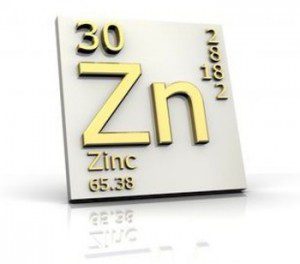Contributing Writer for Wake Up World
Zinc is among the most essential minerals that our body needs, and as always, nature has provided all the zinc we need. However sadly, due to modern day pollution, processing of foods, and genetically modified (GM) crops, many people are now zinc deficient. In fact, some estimations report nearly half of the world’s population is zinc deficient – including the United States.
One excellent source of zinc is from animal meat, but animal feed also comes from the same zinc-depleted soil as our food – resulting in animals that are also zinc deficient. This is not exclusive to conventional raised animals, but also affects organically raised animals due to the same reasons already mentioned: environmental pollutants (such as pesticides), nutritionally depleted soil, and GM crops. Even organic farms cannot escape the pollution and chemicals from other farms due to wind and water run-off from excess rain. (Unless of course we find a way to control the wind and rain, which, no doubt scientists are already trying to do! Chemtrails?) And to compound the problem, we are a society who enjoys large quantities of artificial and fast processed foods and will, sadly, agree to take a prescription drug (or two) rather than change our diet to one that is more nutritious.
Why is Zinc Important for Health?
Zinc is a trace mineral, that is essential for proper immune function (illness and wound healing), repairing DNA damage and DNA synthesis, protective against cancer, protein synthesis, controlling blood sugar, and necessary for maintaining a normal sense of smell and taste.
It is also important to have healthy zinc levels in the body, because zinc is a natural protector against lead, cadmium, and mercury toxicity – heavy metals that carry their own negative impacts on health. If zinc levels in the body are low, then any of these (or all) toxic heavy metals are more readily absorbed by the body.
There are many health conditions related to Zinc Deficiency such as:
- Psoriasis
- Dry Skin
- Type of Anemia
- Pre-eclampsia
- Post-natal depression
- Pre-menstrual syndrome
- Stress
- Chronic Illness
- White spots on fingernails
- Delay in wound healing
- Gastrointestinal disorders
- Macular degeneration
- Heart Disease
- Prostate Enlargement
Even people who eat plenty of whole, organic foods, exercise, and are well-rested can have a decrease in their zinc levels, particularly under certain situations such as:
- Depression due to tragic circumstances
- Prolonged emotional stress
- Extremely athletic
- Excessive alcohol
Although it has been demonstrated that many of our food sources (both from plants and animals) are zinc deficient, there are certain foods that do carry higher percentages of zinc. They are:
- Lamb*
- Grass-fed Beef*
- Veal Liver*
- Turkey
- Oysters*
- Scallops
- Crab*
- Shrimp
- Sesame Seeds*
- Pumpkin Seeds*
- Watermelon Seeds*
- Dark Chocolate*
- Peanuts*
(The highest amounts of zinc are found in those marked *)
Though there is an issue with the seafood listed, due to mercury toxicity and radiation concerns, please eat them with caution. All the other foods listed, should be, of course, organic and GMO Free.
So, how do you know if you really are zinc deficient? And if a deficiency is present, then what can you do about it?
Take the Zinc Tally Test
There is an easy test you can do at home to see if you are zinc deficient or not – the Zinc Tally Test.
Zinc is found abundantly in the human body, down to the cellular level. Because of this, it is often difficult to determine accurate zinc levels via a lab test. Luckily, there is an extremely simple way to know where your zinc level currently is. In fact, zinc is unique, because there is a test you can do from your home to determine if a zinc deficiency is present.
This is also a fairly inexpensive tool because the Zinc Tally lasts for quite a long time, so it gives you plenty of opportunities to retest your zinc levels during extra zinc supplementation.
How Does The Zinc Tally Test Work?
Gustin is the major zinc protein of the human parotid saliva. In other words, gustin is important for our sense of taste.
Because gustin contains zinc, the concentration of gustin changes in proportion to the concentration of zinc that is present in your body. When zinc levels are low, gustin will also be “low”. Because of this relationship the Zinc Tally Test works.
For the test to work most effectively, it is best not to eat or drink for at least 1 hour prior taking it. This makes it a great test to do first thing in the morning.
Take 1 tablespoon of the tally, and swish it around in your mouth…but don’t swallow yet. What you are looking for is, the “type of flavor” you experience while the tally is in your mouth.
- No flavor (water-like) = typical zinc deficiency
- No flavor to start with, but a “mineral” type flavor starts to appear = zinc deficiency
- Strong flavor, but not enough to make you want to spit it out = minimal zinc deficiency
- Extremely unpleasant flavor that you taste immediately = zinc status is good, no zinc deficiency
In most cases, if you are going to taste some sort of “flavor”, it will happen within 5 – 10 seconds. So, any taste that develops after 10 – 15 seconds would be considered a deficiency.
Because the tally is simply zinc sulfate in a base of distilled water, it is safe to swallow after the test, or you can simply spit it out.
What if a Zinc Deficiency is Present?
In the case of a deficiency, zinc supplementation is required. I personally believe that zinc orotate is better absorbed and safer than other forms of zinc, although aspartate is also an excellent carrier of the mineral.
Depending on which category you fall into regarding the Zinc Tally Test, your dosage of zinc may vary. For example, in the case of a mild zinc deficiency, a typical dose of 50 mg to 100 mg is sufficient. After 2 – 3 weeks, re-test with the tally. The more severe the zinc deficiency, the longer it may take to start “tasting” the tally. In some cases, it may take months of zinc supplementation in order for you to begin tasting the tally. If only a minimal zinc deficiency is present, a lower dosage of zinc would be best.
Once you are in the ‘no zinc deficiency’ category, it is important to understand that zinc deficiency has become the standard rule, and not the exception in our society. So, if you decide to cease zinc supplementation, it would be a good idea to repeat the Zinc Tally Test in a few months to ensure your zinc levels have not fallen. Doses of 50 mg to 100 mg may be maintained safely indefinitely.
It is important to know that Zinc and copper are a symbiotic duo, and must be in balance in a 10 to 1 mg ratio respectively. Commonly, many multi-mineral supplements do not have the proper ratio and can actually cause an imbalance. To solve this problem. simply take a trace minerals mixture that you can put into a glass of water.
You can find the Metagenics Zinc Tally Test online by entering “Zinc Tally Test” in Google.
Updated September 2014
Article Sources:
- Researchers Link Low-Level Mercury Exposure, Zinc Deficiency and Learning Disorders
- CADMIUM, THE PSEUDO-MASCULINE MINERAL AND A DEATH MINERAL
- Nutrition to Fight Lead Poisoning
- WARNING! ZINC DEFICIENCY — AS CAUSE OF MODERN ILLNESSES
- Zinc Deficiency in Human Health
- Zinc Deficiency: A Global Nutritional Problem
Previous articles by Dr. Michelle:
- The Link Between Stress and Intestinal Parasites – and What to Do About Them
- Arthritis Cure Found in Nature
- The Sun & Skin Cancer: Examining the Truths, Pseudo-Truths & Lies of Mainstream Science
- “Blame It On Your Genes”: the Money-Making Myth of Modern Medicine
- Just Because Science Can’t Prove It Doesn’t Mean It’s “Pseudoscience”
- Scientists Under Attack — àrpà¡d Pusztai, a GMO Whistleblowing Hero!
- A Natural Cure for Migraines
- The Truth About Aspirin and Cholesterol
- Exposed: Monsanto’s Mission To Pharmaceutically “Enhance” GMO Foods
- Dogma and misinformation: a Fatal Mixture in Healthcare
- Vitamin B12 Deficiency is a Major Health Concern: Here’s Why!
- Natural Cure for Chronic Pain Syndromes Silenced by the Medical Establishment
- Can Cantaloupes Help Prevent Cancer?
- Illness vs. Industry: Will Scientists Ever Find a “Cure” for Cancer?
- Antipsychotics for ADHD? There is Something Wrong with Our Medical Establishment
About the author:
Dr. Michelle Kmiec is a board certified chiropractic physician who also holds a Bachelor of Science degree in Human Biology, and a minor in Medical Research. She is a life-long athlete who after curing herself 100% naturally from MS and anxiety, became an avid nutrition health researcher/promoter. She has been featured in many Health magazines, and has been a guest on radio talk shows in the USA, Canada, United Kingdom, and Australia. She is the author of Health Freedom Revolution: Exposing the Lies, Deceit and Greed of the Medical Profession’, Founder of Online Holistic Health, and a contributing writer for other popular informative health website/blogs. She is also founder of The Triad of Life™ Holistic Lifestyle Program – the most comprehensive holistic program on the internet today.
For more information, visit Online Holistic Health or connect with Dr. Michelle Kmiec on Facebook, Twitter and LinkedIn.
Please note: this article is not intended to give specific medical advice, diagnosis or treatment.

If you've ever found value in our articles, we'd greatly appreciate your support by purchasing Mindful Meditation Techniques for Kids - A Practical Guide for Adults to Empower Kids with the Gift of Inner Peace and Resilience for Life.
In the spirit of mindfulness, we encourage you to choose the paperback version. Delve into its pages away from screen glare and notifications, allowing yourself to fully immerse in the transformative practices within. The physical book enriches the learning process and serves as a tangible commitment to mindfulness, easily shared among family and friends.
Over the past few years, Wake Up World has faced significant online censorship, impacting our financial ability to stay online. Instead of soliciting donations, we're exploring win-win solutions with our readers to remain financially viable. Moving into book publishing, we hope to secure ongoing funds to continue our mission. With over 8,500 articles published in the past 13 years, we are committed to keeping our content free and accessible to everyone, without resorting to a paywall.








